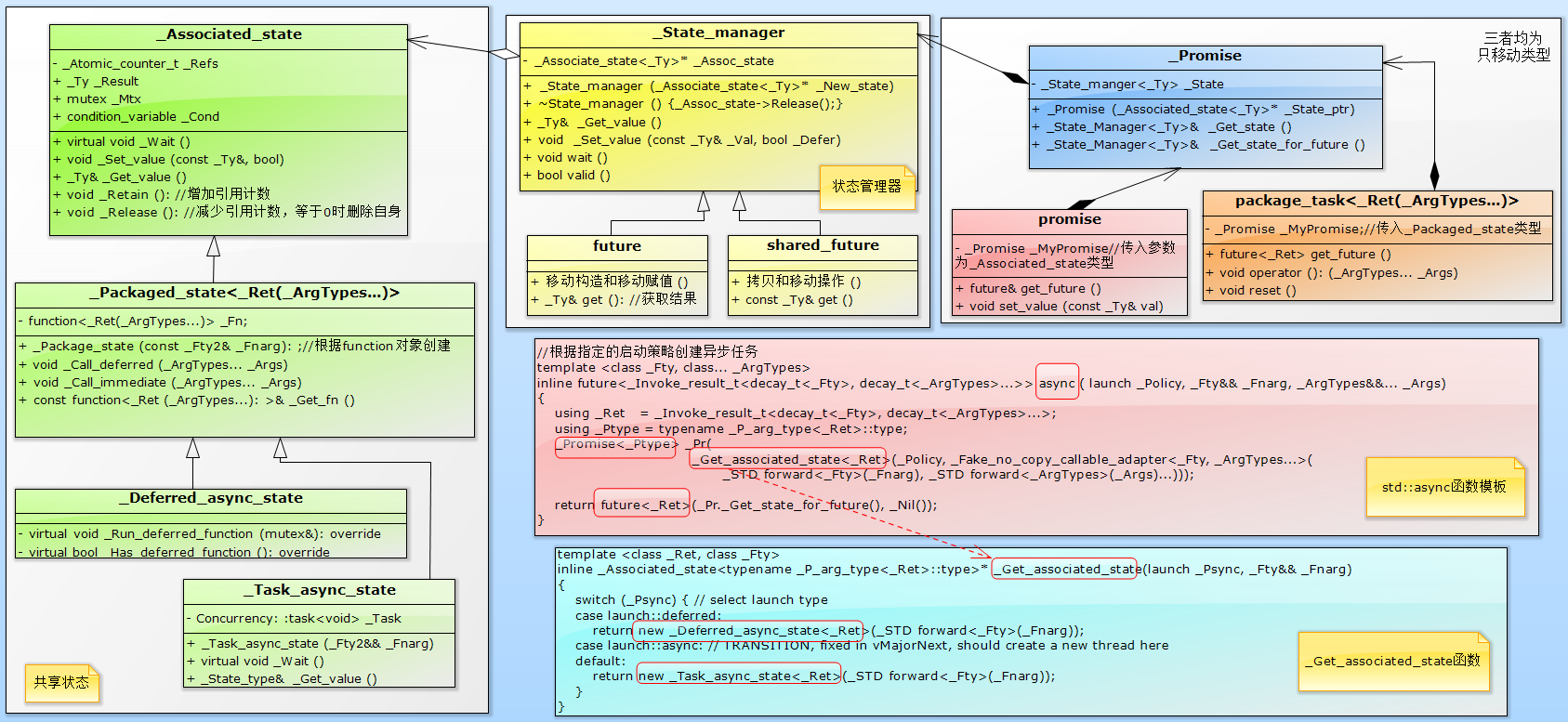第26课 std::async异步任务
一. std::async函数模板
(一)std::async和std::thread的区别
1. 两者最明显的区别在于async采用默认启动策略时并不一定创建新的线程。如果系统资源紧张,那么std::thread创建线程可能失败,系统报告异常,整个程序可能崩溃。而std::async一般则不会,它在无法创建新线程时,会将任务分配给后续调用future.get()函数的线程,并以同步的方式执行(即不创建新线程)。
2. std::async表现为更高阶的抽象,它把用户从线程管理的细节解放出来,将这些责任转交给C++标准库的实现者。而std::thread要求自行处理线程耗尽、超订、负载均衡以及新平台适配问题。
3. std::thread未提供直接获取线程函数返回值的方法。但std::async可以通过future对象来获取。
(二)std::async函数模板及分析

1. “共享状态”对象,用于保存线程函数(一般是可调用对象)及其参数、返回值以及新线程状态等信息。该对象保存在堆中,由std::async、std::promise或std::package_task提供,并交由future或shared_future管理其生命期。被调方(通常指调用promise.set_value()的一方)将计算所得的结果写入“共享状态”,而调用方通过std::future的get()读取该结果。

2. 调用std::async是会创建一个“_Deferred_async_state”或_“Task_async_state”类的“共享状态”对象,该对象是_Packaged_state的子类。注意,直接创建std::promise时,生成的是“_associated_state”类的共享状态对象,而std::package_task创建的是“_Packaged_state”类的共享状态对象。
3. _Get_associated_state是个工厂函数,通过不同的策略创建不同的“共享状态”对象,并将其交由future管理,负责其生命周期。future类似于std::unique_ptr,对“共享状态”对象“独占”所有权。
4. 与std::thread一样,传入std::async中的可调用对象及其参数会被按值以副本形成保存成一个tuple对象,然后再以右值的方式传入线程函数中对应的参数。
【编程实验】创建异步任务
#include <iostream>
#include <thread>
#include <future>
#include <mutex>
#include <vector>
#include <numeric> //for std::accumulate using namespace std; std::mutex mtx; class Widget
{
public:
void foo(int x, const std::string& s)
{
std::lock_guard<std::mutex> lk(mtx);
cout << "thread id = "<<std::this_thread::get_id()<<
" void Foo::foo(int, const std::string&): x = " << x << ", s = " << s<< endl;
} void bar(const std::string& s)
{
std::lock_guard<std::mutex> lk(mtx);
cout << "thread id = " << std::this_thread::get_id()
<<" void Widget::bar(const std::string&): s = " << s << endl;
} void operator()(double val)
{
std::lock_guard<std::mutex> lk(mtx);
cout << "thread id = " << std::this_thread::get_id()
<< " void Widget::operator(): val = " << val << endl;
}
}; class NonCopyable //只移动对象
{
public:
NonCopyable() {}; NonCopyable(const NonCopyable&) = delete;
NonCopyable& operator=(const NonCopyable&) = delete; NonCopyable(NonCopyable&&) = default;
NonCopyable& operator=(NonCopyable&&) = default; double operator()(double d)
{
std::lock_guard<std::mutex> lk(mtx);
cout << "thread id = " << std::this_thread::get_id()
<< " void NonCopyable::operator(): d = " << d << endl;
return d;
}
}; //并行计算
template<typename RandomIt>
int parallel_sum(RandomIt beg, RandomIt end)
{
auto len = end - beg;
if (len < )
{
std::lock_guard<std::mutex> lk(mtx);
cout << "thread id = " << std::this_thread::get_id()
<< " invoke parallel_sum()" << endl;
return std::accumulate(beg, end, ); //遍历[beg,end)区别的每个元素并累加。初始值为0
} RandomIt mid = beg + len / ;
auto handle = std::async(std::launch::async, //子线程将[mid,end)元素进行累加
parallel_sum<RandomIt>, mid, end); int sum = parallel_sum(beg, mid);//本线程将[begin,mid)区间元素进行累加 return sum + handle.get(); //返回两个区间结果的累加和
} int main()
{
Widget w; cout << "main thread id = " << std::this_thread::get_id() << endl;
//1. 参数传递
auto fut1 = std::async(&Widget::foo, &w, , "hello"); //传入this指针:&w
auto fut2 = std::async(&Widget::bar, w, "goodbye"); //传入x的副本如tmp。 tmp.bar(...) auto fut3 = std::async(Widget(), 3.14159); //传入Widget临时对象,调用operator()
auto fut4 = std::async(std::ref(w), 2.718); //传入w的引用,调用operator(); NonCopyable mo; //只移动对象
auto fut5 = std::async(std::move(mo),3.14159); //mo是只移动对象,必须被转为右值 //2. 同步、异步
auto fut6 = std::async(std::launch::async, Widget(), 1.2); //在新线程上运行,operator()
auto fut7 = std::async(std::launch::deferred, &Widget::bar, &w, "deferred"); //线程延迟到调用get或wait才执行 auto fut8 = std::async(std::launch::async | std::launch::deferred, //等价于默认启动策略
&Widget::bar, &w, "async | deferred"); fut7.get(); //主线程阻塞,等待fut7子线程。(子线程延迟到这时才执行)。 //3. 并行计算
std::vector<int> vec(, ); //10000个1
int res = parallel_sum(vec.begin(), vec.end()); {
std::lock_guard<std::mutex> lk(mtx);
cout << "The sum is: " << res << endl; cout << "main thread end." << endl;
} return ;
}
/*输出结果
main thread id = 16756
thread id = 1928 void Foo::foo(int, const std::string&): x = 42, s = hello
thread id = 16756 void Widget::bar(const std::string&): s = deferred //注意,由主线程执行
thread id = 13216 void Widget::bar(const std::string&): s = goodbye
thread id = 7940 void Widget::operator(): val = 3.14159
thread id = 16080 void Widget::operator(): val = 2.718
thread id = 11492 void NonCopyable::operator(): d = 3.14159
thread id = 1928 void Widget::operator(): val = 1.2
thread id = 13216 void Widget::bar(const std::string&): s = async | deferred
thread id = 16756 invoke parallel_sum()
thread id = 7940 invoke parallel_sum()
thread id = 16080 invoke parallel_sum()
thread id = 11492 invoke parallel_sum()
thread id = 1928 invoke parallel_sum()
thread id = 13216 invoke parallel_sum()
thread id = 1928 invoke parallel_sum()
thread id = 7636 invoke parallel_sum()
thread id = 5816 invoke parallel_sum()
thread id = 15856 invoke parallel_sum()
thread id = 15832 invoke parallel_sum()
thread id = 7636 invoke parallel_sum()
thread id = 15400 invoke parallel_sum()
thread id = 16968 invoke parallel_sum()
thread id = 15856 invoke parallel_sum()
thread id = 15476 invoke parallel_sum()
The sum is: 10000
main thread end.
*/
二. std::async的启动策略
(一)std::async的启动策略
1. 三种启动策略(std::async通过指定不同的启动策略来决定创建是“共享状态”对象)
(1)异步方式(std::launch::async):会创建一个“_Task_async_state”类的共享状态对象。使用该策略时异味着线程函数必须以异步的方式运行,即在另一个线程之上执行。
(2)同步方式(std::launch::deferred):会创建一个“_Deferred_async_state”类的共享状态对象。使用该策略意味着线程函数延迟到调用future的get/wait时才得以运行,而且两者是在同一线程上以同步的方式运行。即调用future的一方会阻塞至线程函数运行结束为止。如果get/wait没有得到调用,则线程函数不会被执行。
(3)默认启动策略(std::launch::async|std::launch::deferred):即两者或运算的结果,这意味着任务可能以异步或同步的方式被运行。也就是说是否创建新线程来运行任务,取决于系统资源是否紧张,由标准库的线程管理组件承担线程创建和销毁、避免超订以及负载均衡的责任。
(二)默认启动策略
1. 带来的问题
(1)用户无法预知是异步还是同步运行,因为线程函数可能被调度为延迟执行。
(2)无法预知线程函数是否与调用future的get/wait函数线程是否在同一线程运行。如果此时线程函数会读取线程局部存储(thread_local storage, TLS),那么也就无法预知会取到哪个线程的局部存储。
(3)有时甚至连线程函数是否会运行,这件起码的事情都是无法预知的。这是因此无法保证在程序的每条路径上future的get或wait都会得以调用。
2. 注意事项:
(1)默认启动策略能正常工作需要满足以下所有条件。
①任务不需要与调用get/wait的线程并发执行。
②读/写哪个线程的thread_local变量无关紧要。
③可以保证在std::async返回的future上调用get/wait,或者可以接受任务可能永不执行。
④用户已清楚使用wait_for或wait_unitil的代码任务可能被推迟执行,这种可能性己被纳入考量。
(2)只要其中一个条件不满足,就必须手动指定启动策略以保证任务以异步或同步的方式运行。
【编程实验】默认启动策略问题的解决
#include <iostream>
#include <future> using namespace std;
using namespace literals; //for duration suffixes(时长后缀,如1s) void func()
{
std::this_thread::sleep_for(1s);
} //reallyAsync函数模板:用于保证任务被异步执行
template<typename Func, typename ...Args>
inline auto reallyAsync(Func&& f, Args... args)
{
return std::async(std::launch::async,
std::forward<Func>(func),
std::forward<Args>(args)...);
} int main()
{
//wait_for函数必须可虑任务是同步或异步运行 auto fut1 = std::async(func); //默认启动策略,无法预估任务是被同步还是异步运行 //解决方案1:wait_for(0s)
if (fut1.wait_for(0s) == std::future_status::deferred){ //同步运行,wait_for(0s)
fut1.get(); //等待结果
}else { //异步运行
while (fut1.wait_for(100ms) != std::future_status::ready) { //轮询子线程是否结束
//... //并发做其他任务
} //... //fut is ready
} //解决方案2:确实以异步运行任务
auto fut2 = reallyAsync(func);
while (fut2.wait_for(100ms) != std::future_status::ready) //异步方式,确保wait_for返回ready的结果
{ //从而消除future_status::deferred的可能 } return ;
}
第26课 std::async异步任务的更多相关文章
- C++11 使用异步编程std::async和std::future
先说明一点:std::asyanc是std::future的高级封装, 一般我们不会直接使用std::futrue,而是使用对std::future的高级封装std::async. 下面分别说一下. ...
- C++11 使用 std::async创建异步程序
c++11中增加了线程,使得我们可以非常方便的创建线程,它的基本用法是这样的: void f(int n); std::thread t(f, n + 1); t.join(); 但是线程毕竟是属于比 ...
- 异步编程系列第01章 Async异步编程简介
p { display: block; margin: 3px 0 0 0; } --> 2016.10.11补充 三个月过去了,回头来看,我不得不承认这是一系列失败的翻译.过段时间,我将重新翻 ...
- 用C++11的std::async代替线程的创建
c++11中增加了线程,使得我们可以非常方便的创建线程,它的基本用法是这样的: void f(int n); std::thread t(f, n + 1); t.join(); 但是线程毕竟是属于比 ...
- C++ std::async vs async/await in C# - Stack Overflow
C++ std::async vs async/await in C# - Stack Overflow 我想知道新的c ++功能std::async是否与两个C#关键字async / await相当 ...
- C++并发编程之std::async(), std::future, std::promise, std::packaged_task
c++11中增加了线程,使得我们可以非常方便的创建线程,它的基本用法是这样的: void f(int n); std::thread t(f, n + 1); t.join(); 但是线程毕竟是属于比 ...
- (原创)用C++11的std::async代替线程的创建
c++11中增加了线程,使得我们可以非常方便的创建线程,它的基本用法是这样的: void f(int n); std::thread t(f, n + ); t.join(); 但是线程毕竟是属于比较 ...
- C++ 0x std::async 的应用
#include <iostream> #include <thread> #include <mutex> #include <vector> #in ...
- C++11 std::async 包装实体店::packaged_task
更好的方式 C++11中提供了操作多线程的高层次特性. std::packaged_task 包装的是一个异步操作,相当与外包任务,好比我大阿里把电话客服外包给某某公司. std::future 提供 ...
随机推荐
- IDEA 日常小技巧
原文首发于 studyidea.cn点击查看更多技巧 适用于 IDEA 2019.2 之前版本 ,2019.2 版本以下功能默认开启. Surround a selection with a quot ...
- python 统计使用技巧
python 统计使用技巧 # 1.不输入回车获取值 注:需要tty模块配合. fd = sys.stdin.fileno() old_settings = termios.tcgetattr(fd) ...
- 【UOJ#82】【UR #7】水题生成器(贪心)
[UOJ#82][UR #7]水题生成器(贪心) 题面 UOJ 题解 把\(n!\)的所有约数搜出来,这个个数不会很多. 然后从大往小能选则选就好了. #include<iostream> ...
- WinForms中动态给treeView的节点添加ContextMenuStrip,并绑定Click事件
生成ContextMenuStrip var docMenu = new ContextMenuStrip(); ToolStripMenuItem deleteMenuItem = new Tool ...
- CSS函数大全
CSS函数(方法)参考 CSS函数用作各种CSS属性的值. 函数 描述 attr() 返回所选元素的属性值 calc() 允许您执行计算以确定CSS属性值 cubic-bezier() 定义Cubic ...
- 绕过基于签名的XSS筛选器:修改HTML
绕过基于签名的XSS筛选器:修改HTML 在很多情况下,您可能会发现基于签名的过滤器只需切换到一个不太熟悉的执行脚本的方法即可.如果失败了,您需要查看混淆攻击的方法. 本文提供了HTML语法可以被混淆 ...
- 如何在浏览器中运行 VS Code?
摘要: WEB IDE新时代! 作者:SHUHARI 的博客 原文:有趣的项目 - 在浏览器中运行 Visual Studio Code Fundebug按照原文要求转载,版权归原作者所有. 众所周知 ...
- HDFS常用API操作 和 HDFS的I/O流操作
前置操作 创建maven工程,修改pom.xml文件: <project xmlns="http://maven.apache.org/POM/4.0.0" xmlns:xs ...
- win10无法在桌面右键快捷打开个性化设置、显示设置,在任务栏右键无法快捷打开任务栏设置
Win+R,输入regedit,定位到HKEY_CURRENT_USER\Software\Classes\ 找到列表中的ms-settings 将其删除即可解决! 转自百度知道
- [Linux]F5负载均衡器
F5负载均衡器是硬件的负载均衡设备 F5配置最简单负载均衡,需要配置的参数有Node(节点).Pool(资源池).和Virtual Server(虚拟服务器),它们的关系是,先配置Node,然后配置V ...
